Sheffield
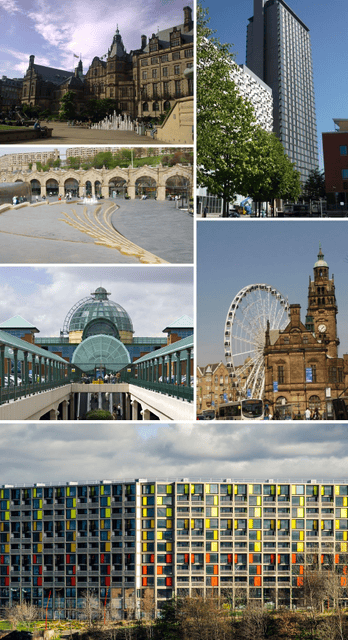
Sheffield

Sheffield | ||
|---|---|---|
City and metropolitan borough | ||
| Nickname(s): ‘Steel City’ | ||
| Motto(s): ’Deo Adjuvante Labor Proficit’ (Latin: ’With God's help our labour is successful’) | ||
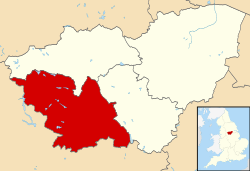 Sheffield shown within South Yorkshire | ||
| Coordinates:53°23′N 1°28′W [246] | ||
| Sovereign state | United Kingdom | |
| Constituent country | England | |
| Region | Yorkshire and the Humber | |
| Ceremonial county | South Yorkshire | |
| Historic county | Yorkshire Urban core and outlying areas Derbyshire Some southern suburbs | |
| Founded | c. 8th century | |
| Town charter | 10 August 1297 | |
| City status | 1893 | |
| Administrative HQ | Sheffield Town Hall | |
| Government | ||
| • Type | Metropolitan borough and city | |
| • Governing body | Sheffield City Council | |
| • Lord Mayor | Tony Downing (Labour) | |
| • Council Leader | Julie Dore (Labour) | |
| • MPs: | Clive Betts (Labour) Paul Blomfield (Labour) Jared O'Mara (Ind) Louise Haigh (Labour) Gill Furniss (Labour Co-op) Angela Smith (Ind) | |
| Area | ||
| • City | 142.06 sq mi (367.94 km2) | |
| Population (mid-2018 est.) | ||
| • City | 582,506 (Ranked 3rd) | |
| • Density | 4,100/sq mi (1,570/km2) | |
| • Urban | 685,368 (Sheffield urban area) | |
| • Urban density | 10,600/sq mi (4,092/km2) | |
| • Metro | 1,569,000 [1] | |
| • Ethnicity | Ethnic groups
| |
| Demonym(s) | Sheffielder | |
| Time zone | UTC+0 (Greenwich Mean Time) | |
| Postcode | S | |
| Area code(s) | 0114 | |
| Website | www.sheffield.gov.uk [247] | |
| Labour profile | ||
| Total employee jobs | 255,700 | |
| Full-time | 168,000 | 65.7% |
| Part-time | 87,700 | 34.3% |
| Manufacturing | 31,800 | 12.4% |
| Construction | 8,500 | 3.3% |
| Services | 214,900 | 84.1% |
| Distribution, hotels & restaurants | 58,800 | 23.0% |
| Transport & communications | 14,200 | 5.5% |
| Finance, IT, other business activities | 51,800 | 20.2% |
| Public admin, education & health | 77,500 | 30.3% |
| Other services | 12,700 | 5.0% |
| Tourism-related | 18,400 | 7.2% |
Sheffield is a city and metropolitan borough in South Yorkshire, England. Historically part of the West Riding of Yorkshire, its name derives from the River Sheaf, which runs through the city. With some of its southern suburbs annexed from Derbyshire, the city has grown from its largely industrial roots to encompass a wider economic base. The population of the City of Sheffield is 582,506 (mid-2018 est.)[2] and it is one of the eight largest regional English cities that make up the Core Cities Group.[3] Sheffield is the third-largest English district by population. The metropolitan population of Sheffield is 1,569,000.[1]
The city is in the eastern foothills of the Pennines, and the valleys of the River Don and its four tributaries, the Loxley, the Porter Brook, the Rivelin and the Sheaf. Sixty-one per cent of Sheffield's entire area is green space, and a third of the city lies within the Peak District national park.[4] There are more than 250 parks, woodlands and gardens in the city,[4] which is estimated to contain around 4.5 million trees.[5]
Sheffield played a crucial role in the Industrial Revolution, with many significant inventions and technologies developed in the city. In the 19th century, the city saw a huge expansion of its traditional cutlery trade, when stainless steel and crucible steel were developed locally, fuelling an almost tenfold increase in the population. Sheffield received its municipal charter in 1843, becoming the City of Sheffield in 1893. International competition in iron and steel caused a decline in these industries in the 1970s and 1980s, coinciding with the collapse of coal mining in the area.
The 21st century has seen extensive redevelopment in Sheffield, along with other British cities. Sheffield's gross value added (GVA) has increased by 60% since 1997, standing at £9.2 billion in 2007. The economy has experienced steady growth averaging around 5% annually, greater than that of the broader region of Yorkshire and the Humber.[6]
The city has a long sporting heritage, and is home to the world's oldest football club, Sheffield F.C.[7] Games between the two professional clubs, Sheffield United and Sheffield Wednesday, are known as the Steel City derby. The city is also home to the World Snooker Championship and the Sheffield Steelers, the UK's first professional ice hockey team.
Sheffield | ||
|---|---|---|
City and metropolitan borough | ||
| Nickname(s): ‘Steel City’ | ||
| Motto(s): ’Deo Adjuvante Labor Proficit’ (Latin: ’With God's help our labour is successful’) | ||
 Sheffield shown within South Yorkshire | ||
| Coordinates:53°23′N 1°28′W [246] | ||
| Sovereign state | United Kingdom | |
| Constituent country | England | |
| Region | Yorkshire and the Humber | |
| Ceremonial county | South Yorkshire | |
| Historic county | Yorkshire Urban core and outlying areas Derbyshire Some southern suburbs | |
| Founded | c. 8th century | |
| Town charter | 10 August 1297 | |
| City status | 1893 | |
| Administrative HQ | Sheffield Town Hall | |
| Government | ||
| • Type | Metropolitan borough and city | |
| • Governing body | Sheffield City Council | |
| • Lord Mayor | Tony Downing (Labour) | |
| • Council Leader | Julie Dore (Labour) | |
| • MPs: | Clive Betts (Labour) Paul Blomfield (Labour) Jared O'Mara (Ind) Louise Haigh (Labour) Gill Furniss (Labour Co-op) Angela Smith (Ind) | |
| Area | ||
| • City | 142.06 sq mi (367.94 km2) | |
| Population (mid-2018 est.) | ||
| • City | 582,506 (Ranked 3rd) | |
| • Density | 4,100/sq mi (1,570/km2) | |
| • Urban | 685,368 (Sheffield urban area) | |
| • Urban density | 10,600/sq mi (4,092/km2) | |
| • Metro | 1,569,000 [1] | |
| • Ethnicity | Ethnic groups
| |
| Demonym(s) | Sheffielder | |
| Time zone | UTC+0 (Greenwich Mean Time) | |
| Postcode | S | |
| Area code(s) | 0114 | |
| Website | www.sheffield.gov.uk [247] | |
| Labour profile | ||
| Total employee jobs | 255,700 | |
| Full-time | 168,000 | 65.7% |
| Part-time | 87,700 | 34.3% |
| Manufacturing | 31,800 | 12.4% |
| Construction | 8,500 | 3.3% |
| Services | 214,900 | 84.1% |
| Distribution, hotels & restaurants | 58,800 | 23.0% |
| Transport & communications | 14,200 | 5.5% |
| Finance, IT, other business activities | 51,800 | 20.2% |
| Public admin, education & health | 77,500 | 30.3% |
| Other services | 12,700 | 5.0% |
| Tourism-related | 18,400 | 7.2% |
History

Sheffield Manor ruins as they appeared c. 1819
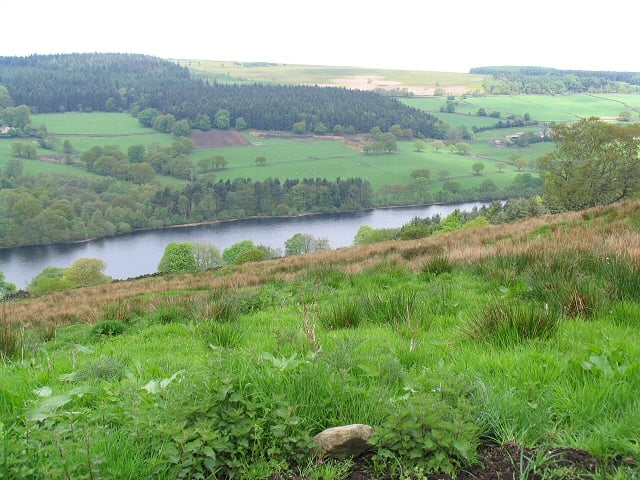
Dale Dike Reservoir: the original dam wall of this reservoir collapsed in 1864 causing the Great Sheffield Flood

The Women of Steel statue commemorates the women of Sheffield who worked in the city's steel industry during the First and Second World Wars
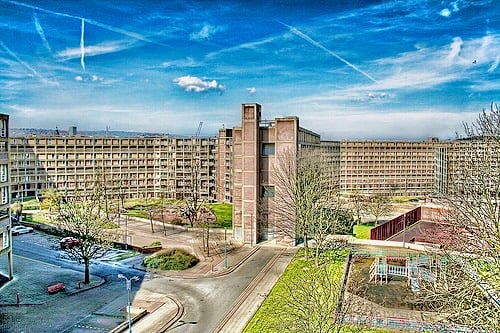
Park Hill flats, an example of 1950s and 1960s council housing estates in Sheffield
The area now occupied by the City of Sheffield is believed to have been inhabited since at least the late Upper Paleolithic, about 12,800 years ago.[8] The earliest evidence of human occupation in the Sheffield area was found at Creswell Crags to the east of the city. In the Iron Age the area became the southernmost territory of the Pennine tribe called the Brigantes. It is this tribe who are thought to have constructed several hill forts in and around Sheffield.[9]
Following the departure of the Romans, the Sheffield area may have been the southern part of the Brittonic kingdom of Elmet, with the rivers Sheaf and Don forming part of the boundary between this kingdom and the kingdom of Mercia.[10] Gradually, Anglian settlers pushed west from the kingdom of Deira. A Britonnic presence within the Sheffield area is evidenced by two settlements called Wales and Waleswood close to Sheffield.[11] The settlements that grew and merged to form Sheffield, however, date from the second half of the first millennium, and are of Anglo-Saxon and Danish origin.[9] In Anglo-Saxon times, the Sheffield area straddled the border between the kingdoms of Mercia and Northumbria. The Anglo-Saxon Chronicle reports that Eanred of Northumbria submitted to Egbert of Wessex at the hamlet of Dore (now a suburb of Sheffield) in 829,[12] a key event in the unification of the kingdom of England under the House of Wessex.[13]
After the Norman conquest of England, Sheffield Castle was built to protect the local settlements, and a small town developed that is the nucleus of the modern city.[14] By 1296, a market had been established at what is now known as Castle Square,[15] and Sheffield subsequently grew into a small market town. In the 14th century, Sheffield was already noted for the production of knives, as mentioned in Geoffrey Chaucer's The Canterbury Tales,[16] and by the early 1600s it had become the main centre of cutlery manufacture in England outside London, overseen by the Company of Cutlers in Hallamshire.[17] From 1570 to 1584, Mary, Queen of Scots, was imprisoned in Sheffield Castle and Sheffield Manor.[18]
During the 1740s, a form of the crucible steel process was discovered that allowed the manufacture of a better quality of steel than had previously been possible.[19] In about the same period, a technique was developed for fusing a thin sheet of silver onto a copper ingot to produce silver plating, which became widely known as Sheffield plate.[20] These innovations spurred Sheffield's growth as an industrial town,[21] but the loss of some important export markets led to a recession in the late 18th and early 19th century. The resulting poor conditions culminated in a cholera epidemic that killed 402 people in 1832.[9] The population of the town grew rapidly throughout the 19th century; increasing from 60,095 in 1801 to 451,195 by 1901.[9] The Sheffield and Rotherham railway was constructed in 1838, connecting the two towns. The town was incorporated as a borough in 1842, and was granted a city charter in 1893.[22] The influx of people also led to demand for better water supplies, and a number of new reservoirs were constructed on the outskirts of the town.
The collapse of the dam wall of one of these reservoirs in 1864 resulted in the Great Sheffield Flood, which killed 270 people and devastated large parts of the town.[23] The growing population led to the construction of many back-to-back dwellings that, along with severe pollution from the factories, inspired George Orwell in 1937 to write: "Sheffield, I suppose, could justly claim to be called the ugliest town in the Old World".[24]
The Great Depression hit the city in the 1930s, but as international tensions increased and the Second World War became imminent; Sheffield's steel factories were set to work manufacturing weapons and ammunition for the war effort. As a result, the city became a target for bombing raids, the heaviest of which occurred on the nights of 12 and 15 December 1940, now known as the Sheffield Blitz. The city was protected by barrage balloons managed from RAF Norton [25] More than 660 lives were lost and many buildings destroyed.[26]
In the 1950s and 1960s, many of the city's slums were demolished, and replaced with housing schemes such as the Park Hill flats. Large parts of the city centre were also cleared to make way for a new system of roads.[9] Increased automation and competition from abroad resulted in the closure of many steel mills. The 1980s saw the worst of this run-down of Sheffield's industries, along with those of many other areas of the UK.[27] The building of the Meadowhall Centre on the site of a former steelworks in 1990 was a mixed blessing, creating much-needed jobs but hastening the decline of the city centre. Attempts to regenerate the city were kick-started when the city hosted the 1991 World Student Games, which saw the construction of new sporting facilities such as the Sheffield Arena, Don Valley Stadium and the Ponds Forge complex.[9]
Sheffield is changing rapidly as new projects regenerate some of the more run-down parts of the city. One such, the Heart of the City Project, has initiated a number of public works in the city centre: the Peace Gardens were renovated in 1998, the Millennium Galleries opened in April 2001, the Winter Gardens were opened in May 2003, and a public space to link these two areas, the Millennium Square, was opened in May 2006. Additional developments included the remodelling of Sheaf Square, in front of the refurbished railway station. The square contains "The Cutting Edge", a sculpture designed by Si Applied Ltd[28] and made from Sheffield steel.
Sheffield was particularly hard hit during the 2007 United Kingdom floods and the 2010 'Big Freeze'. Many landmark buildings such as Meadowhall and the Sheffield Wednesday ground flooded due to being close to rivers that flow through the city. In 2010, 5,000 properties in Sheffield were identified as still being at risk of flooding. In 2012 the city narrowly escaped another flood, despite extensive work by the Environment Agency to clear local river channels since the 2007 event. In 2014 Sheffield Council's cabinet approved plans to further reduce the possibility of flooding by adopting plans to increase water catchment on tributaries of the River Don.[29][30][31]
Since 2012, there have been disputes between the city council and residents over the fate of the city's 36,000 highway trees, with 4,000 having been felled as part of a scheme to maintain the city streets.[32] However, there have been plans for the highway maintenance to replant all felled trees across the city, including those historically felled and not previously replanted.[33]
Governance

Sheffield Town Hall, adjacent to the Peace Gardens, is an example of Victorian era Gothic revival architecture.
Sheffield is governed at the local level by Sheffield City Council. It consists of 84 councillors elected to represent 28 wards: three councillors per ward. Following the 2016 local elections, the distribution of council seats is Labour 56, Liberal Democrats 20, the Green Party 4 and UKIP 4. The city also has a Lord Mayor; though now simply a ceremonial position, in the past the office carried considerable authority, with executive powers over the finances and affairs of the city council.
For much of its history the council was controlled by the Labour Party, and was noted for its leftist sympathies; during the 1980s, when Sheffield City Council was led by David Blunkett, the area gained the epithet the "Socialist Republic of South Yorkshire".[34] However, the Liberal Democrats controlled the Council between 1999 and 2001 and took control again from 2008 to 2011.
The majority of council-owned facilities are operated by independent charitable trusts. Sheffield International Venues runs many of the city's sporting and leisure facilities, including Sheffield Arena and the English Institute of Sport. Museums Sheffield and the Sheffield Industrial Museums Trust take care of galleries and museums owned by the council.[35][36]
The city returns five members of parliament to the House of Commons, with a sixth, the Member of Parliament for Penistone and Stocksbridge representing parts of Sheffield and Barnsley.[37] The former Deputy Prime Minister Nick Clegg was an MP for Sheffield, representing Sheffield Hallam.
Geography
Sheffield is located at 53°23′N 1°28′W [248] . It lies directly beside Rotherham, from which it is separated largely by the M1 motorway. Although Barnsley Metropolitan Borough also borders Sheffield to the north, the town itself is a few miles further away. The southern and western borders of the city are shared with Derbyshire; in the first half of the 20th century Sheffield extended its borders south into Derbyshire, annexing a number of villages,[38] including Totley, Dore and the area now known as Mosborough Townships. Directly to the west of the city are the Peak District National Park and the Pennine upland range, while the lowlands of the South Yorkshire Coalfield lie to the east.
Sheffield is a geographically diverse city.[39] Lying in the eastern foothills of the Pennines,[40] the city nestles in a natural amphitheatre created by several hills[41] and the confluence of five rivers: Don, Sheaf, Rivelin, Loxley and Porter. As such, much of the city is built on hillsides with views into the city centre or out to the countryside. Blake Street, in the S6 postcode area, is the third steepest residential street in England, with a gradient of 16.6°.[42] The city's lowest point is just 29 metres (95 ft) above sea level near Blackburn Meadows, while some parts of the city are at over 500 metres (1,640 ft); the highest point being 548 metres (1,798 ft) at High Stones, near Margery Hill. However, 79% of the housing in the city is between 100 and 200 metres (330 and 660 ft) above sea level.[43]
Estimated to contain around 4.5 million trees,[5] Sheffield has more trees per person than any other city in Europe, and it is claimed by Sheffield City Council to be England's greenest city,[44] a claim that was reinforced when it won the 2005 Entente Florale competition. With more than 250 parks, woodlands and gardens, it has over 170 woodlands (covering 10.91 sq mi or 28.3 km2), 78 public parks (covering 7.07 sq mi or 18.3 km2) and 10 public gardens. Added to the 52.0 square miles (134.7 km2) of national park and 4.20 square miles (10.9 km2) of water this means that 61% of the city is greenspace. Despite this, about 64% of Sheffield householders live further than 300 metres (328 yd) from their nearest greenspace, although access is better in less affluent neighbourhoods across the city.[4][45] Sheffield also has a very wide variety of habitat, comparing favourably with any city in the United Kingdom: urban, parkland and woodland, agricultural and arable land, moors, meadows and freshwater-based habitats. There are six areas within the city that are designated as sites of special scientific interest.[46]
The present city boundaries were set in 1974 (with slight modification in 1994), when the former county borough of Sheffield merged with Stocksbridge Urban District and two parishes from the Wortley Rural District.[4] This area includes a significant part of the countryside surrounding the main urban region. Roughly a third of Sheffield lies in the Peak District National Park. No other English city had parts of a national park within its boundary,[47] until the creation in March 2010 of the South Downs National Park, part of which lies within Brighton and Hove.
Climate
Like the rest of the United Kingdom, the climate in Sheffield is generally temperate. The Pennines to the west of the city can create a cool, gloomy and wet environment, but they also provide shelter from the prevailing westerly winds, casting a "rain shadow" across the area.[48] Between 1971 and 2000 Sheffield averaged 824.7 millimetres (32.47 in) of rain per year; December was the wettest month with 91.9 millimetres (3.62 in) and July the driest with 51.0 millimetres (2.01 in). July was also the hottest month, with an average maximum temperature of 20.8 °C (69.4 °F). The highest temperature ever recorded in the city of Sheffield was 35.6 °C (96.1 °F), on 25 July 2019.[49] The average minimum temperature in January and February was 1.6 °C (34.9 °F),[50] though the lowest temperatures recorded in these months can be between −10 and −15 °C (14 and 5 °F), although since 1960, the temperature has never fallen below −9.2 °C (15.4 °F),[51] suggesting that urbanisation around the Weston Park site during the second half of the 20th century may prevent temperatures below −10 °C (14 °F) occurring.
The coldest temperature to be recorded in recent years was −8.2 °C (17.2 °F).[52] (Note: The official Weston Park Weather Station statistics, which can also be viewed at Sheffield Central Library, has the temperature at −8.7 °C (16.3 °F), recorded on 20 December, and states that to be the lowest December temperature since 1981.) The coldest temperature ever recorded in the city of Sheffield at Weston Park, since records began in 1882, is −14.6 °C (5.7 °F), registered in February 1895.[53] The lowest daytime maximum temperature in the city since records began is −5.6 °C (21.9 °F), also recorded in February 1895. More recently, a −4.4 °C (24.1 °F) was recorded as a daytime maximum at Weston Park, on 20 December 2010.(from the Weston Park Weather Station statistics, which also can be viewed at Sheffield Central Library.) On average, through the winter months of December to March, there are 67 days during which ground frost occurs.[48]
| Climate data for Sheffield Cdl, elevation: 131 m (430 ft), 1981–2010 normals, extremes 1960–present | |||||||||||||
|---|---|---|---|---|---|---|---|---|---|---|---|---|---|
| Month | Jan | Feb | Mar | Apr | May | Jun | Jul | Aug | Sep | Oct | Nov | Dec | Year |
| Record high °C (°F) | 14.9 (58.8) | 18.2 (64.8) | 23.3 (73.9) | 26.4 (79.5) | 28.2 (82.8) | 30.7 (87.3) | 35.6 (96.1) | 34.3 (93.7) | 28.4 (83.1) | 25.7 (78.3) | 17.6 (63.7) | 17.6 (63.7) | 35.6 (96.1) |
| Average high °C (°F) | 6.8 (44.2) | 7.1 (44.8) | 9.8 (49.6) | 12.5 (54.5) | 16.1 (61.0) | 18.8 (65.8) | 21.1 (70.0) | 20.6 (69.1) | 17.7 (63.9) | 13.5 (56.3) | 9.5 (49.1) | 6.9 (44.4) | 13.4 (56.1) |
| Daily mean °C (°F) | 4.4 (39.9) | 4.4 (39.9) | 6.6 (43.9) | 8.7 (47.7) | 11.8 (53.2) | 14.7 (58.5) | 16.9 (62.4) | 16.5 (61.7) | 14.0 (57.2) | 10.5 (50.9) | 7.0 (44.6) | 4.6 (40.3) | 10.0 (50.0) |
| Average low °C (°F) | 1.9 (35.4) | 1.7 (35.1) | 3.3 (37.9) | 4.8 (40.6) | 7.5 (45.5) | 10.5 (50.9) | 12.7 (54.9) | 12.4 (54.3) | 10.3 (50.5) | 7.5 (45.5) | 4.5 (40.1) | 2.3 (36.1) | 6.6 (43.9) |
| Record low °C (°F) | −9.2 (15.4) | −8.3 (17.1) | −8.3 (17.1) | −6.6 (20.1) | −0.7 (30.7) | 1.4 (34.5) | 3.9 (39.0) | 4.2 (39.6) | 1.9 (35.4) | −4.1 (24.6) | −7.2 (19.0) | −9.1 (15.6) | −9.2 (15.4) |
| Average precipitation mm (inches) | 83.4 (3.28) | 60.4 (2.38) | 63.4 (2.50) | 65.5 (2.58) | 53.8 (2.12) | 75.6 (2.98) | 56.0 (2.20) | 65.3 (2.57) | 63.8 (2.51) | 81.2 (3.20) | 79.4 (3.13) | 86.7 (3.41) | 834.6 (32.86) |
| Average rainy days(≥ 1.0 mm) | 13.4 | 10.5 | 12.3 | 10.3 | 9.6 | 9.1 | 9.2 | 9.9 | 8.9 | 12.7 | 12.6 | 13.0 | 131.6 |
| Mean monthly sunshine hours | 45.2 | 68.3 | 111.9 | 144.0 | 190.9 | 179.5 | 199.5 | 185.0 | 136.2 | 90.7 | 53.7 | 40.0 | 1,444.9 |
| Average ultraviolet index | 0 | 1 | 2 | 4 | 5 | 6 | 6 | 5 | 4 | 2 | 1 | 0 | 3 |
| Source #1: Met Office[54] | |||||||||||||
| Source #2: KNMI[55][56] and WeatherAtlas[57] | |||||||||||||
The Weston Park Weather station, established in 1882, is one of the longest running weather stations in the United Kingdom. It has recorded weather for more than 125 years, and a 2008 report showed that the climate of Sheffield is warming faster than it has at any time during this period, with 1990 and 2006 being the hottest years on record.[58] In collaboration with the Stockholm Environment Institute, Sheffield developed a carbon footprint (based on 2004/05 consumption figures) of 5,798,361 tonnes per year. This compares to the UK's total carbon footprint of 698,568,010 tonnes per year. The factors with the greatest impact are housing (34%), transport (25%), consumer (11%), private services (9%), public services (8%), food (8%) and capital investment (5%).[59] Sheffield City Council has signed up to the 10:10 campaign.[60]
Green belt
Sheffield is within a green belt region that extends into the wider surrounding counties, and is in place to reduce urban sprawl, prevent the towns and areas in the Sheffield built-up area conurbation from further convergence, protect the identity of outlying communities, encourage brownfield reuse, and preserve nearby countryside. This is achieved by restricting inappropriate development within the designated areas, and imposing stricter conditions on permitted building.[61][62] The main urban area and larger villages of the borough are exempt from the green belt area, but surrounding smaller villages, hamlets and rural areas are 'washed over' with the designation. A subsidiary aim of the green belt is to encourage recreation and leisure interests,[61] with many rural landscape features and facilities included.
Subdivisions
Sheffield is made up of many suburbs and neighbourhoods, many of which developed from villages or hamlets that were absorbed into Sheffield as the city grew.[9] These historical areas are largely ignored by the modern administrative and political divisions of the city; instead it is divided into 28 electoral wards, with each ward generally covering 4–6 areas.[63] These electoral wards are grouped into six parliamentary constituencies. Sheffield is largely unparished, but Bradfield and Ecclesfield have parish councils, and Stocksbridge has a town council.[64]
Skyline
Demography
| Population Change | ||
|---|---|---|
| Year | Pop. | ±% |
| 1801 | 60,095 | — |
| 1821 | 84,540 | +40.7% |
| 1841 | 134,599 | +59.2% |
| 1861 | 219,634 | +63.2% |
| 1881 | 335,953 | +53.0% |
| 1901 | 451,195 | +34.3% |
| 1921 | 543,336 | +20.4% |
| 1941 | 569,884 | +4.9% |
| 1951 | 577,050 | +1.3% |
| 1961 | 574,915 | −0.4% |
| 1971 | 572,794 | −0.4% |
| 1981 | 530,844 | −7.3% |
| 1991 | 528,708 | −0.4% |
| 2001 | 513,234 | −2.9% |
| 2011 | 551,800 | +7.5% |
| [65] | ||
The United Kingdom Census 2001 reported a resident population for Sheffield of 513,234, a 2% decline from the 1991 census.[66] The city is part of the wider Sheffield urban area, which had a population of 640,720.[67] In 2011 the racial composition of Sheffield's population was 84% White (81% White British, 0.5% White Irish, 0.1% Gypsy or Irish Traveller, 2.3% Other White), 2.4% of mixed race (1.0% White and Black Caribbean, 0.2% White and Black African, 0.6% White and Asian, 0.6% Other Mixed), 8% Asian (1.1% Indian, 4% Pakistani, 0.6% Bangladeshi, 1.3% Chinese, 1.0% Other Asian), 3.6% Black (2.1% African, 1% Caribbean, 0.5% Other Black), 1.5% Arab and 0.7% of other ethnic heritage.[68] In terms of religion, 53% of the population are Christian, 6% are Muslim, 0.6% are Hindu, 0.4% are Buddhist, 0.2% are Sikh, 0.1% are Jewish, 0.4% belong to another religion, 31% have no religion and 7% did not state their religion.[69] The largest quinary group is 20- to 24-year-olds (9%) because of the large university student population.[70]
The population of Sheffield peaked in 1951 at 577,050, and has since declined steadily. However, the mid-2007 population estimate was 530,300, representing an increase of about 17,000 residents since 2001.[71]
Although a city, Sheffield is informally known as "the largest village in England",[72][73][74] because of a combination of topographical isolation and demographic stability.[72] It is relatively geographically isolated, being cut off from other places by a ring of hills.[75][76] Local folklore insists that, like Rome, Sheffield was built "on seven hills".[76] The land surrounding Sheffield was unsuitable for industrial use,[72] and now includes several protected green belt areas.[77] These topographical factors have served to restrict urban spread,[77] resulting in a relatively stable population size and a low degree of mobility.
Economy

St Paul's Place, 2010. St Paul's Tower, the tallest building in Sheffield, is in the centre.
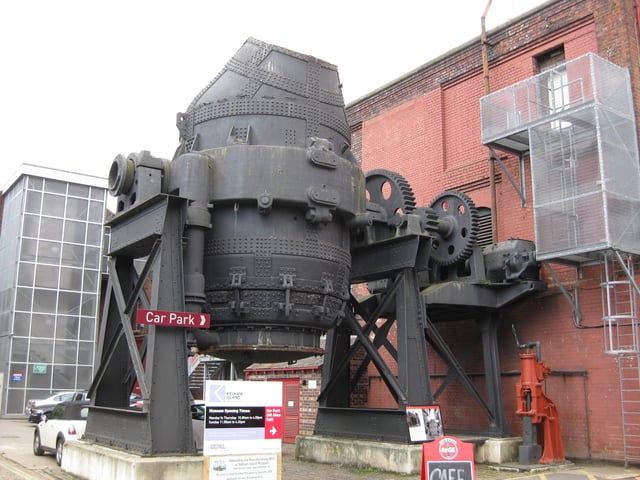
Sir Henry Bessemer’s Bessemer converter, the most important technique for making steel from the 1850s to the 1950s, located at Kelham Island Museum, Sheffield

Monument to Harry Brearley and the birthplace of stainless steel at the former Brown Firth Research Laboratories
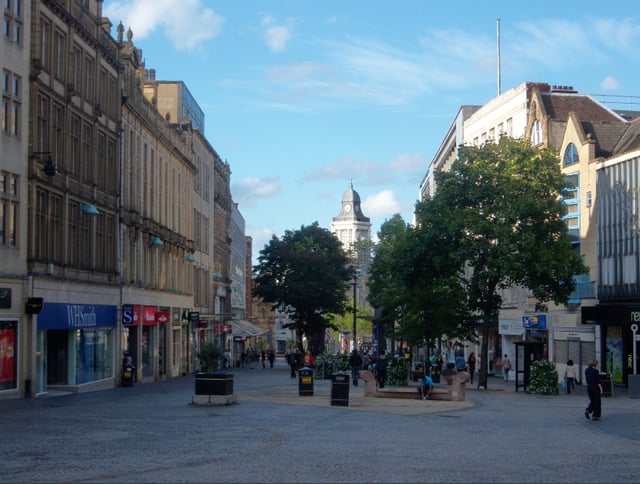
Fargate shopping area
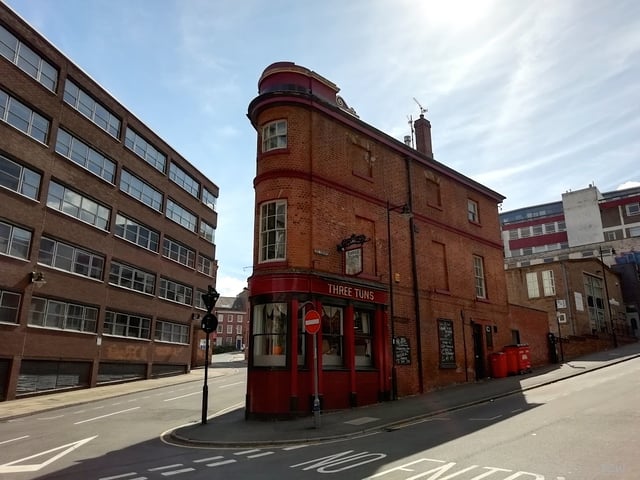
The Three Tuns, Sheffield, the iconic triangular, corner architectural delight, and former Nun's washhouse, circa early 1800s
After many years of decline, the Sheffield economy is going through a strong revival. The 2004 Barclays Bank Financial Planning study[78] revealed that, in 2003, the Sheffield district of Hallam was the highest ranking area outside London for overall wealth, the proportion of people earning over £60,000 a year standing at almost 12%. A survey by Knight Frank[79] revealed that Sheffield was the fastest-growing city outside London for office and residential space and rents during the second half of 2004. This can be seen in a surge of redevelopments, including the City Lofts Tower and accompanying St Paul's Place, Velocity Living and the Moor redevelopment,[80] the forthcoming NRQ and the Winter Gardens, Peace Gardens, Millennium Galleries and many projects completed under the Sheffield One redevelopment agency. The Sheffield economy grew from £5.6 billion in 1997 (1997 GVA)[81] to £9.2 billion in 2007 (2007 GVA).[82]
The "UK Cities Monitor 2008" placed Sheffield among the top ten "best cities to locate a business today", the city occupying third and fourth places respectively for best office location and best new call centre location. The same report places Sheffield in third place regarding "greenest reputation" and second in terms of the availability of financial incentives.[83]
Sheffield has an international reputation for metallurgy and steel-making.[84] Playing a crucial role in the Industrial Revolution, the city became an industrial powerhouse in the 18th century, and was dubbed “Steel City”.[85] Many innovations in these fields have been made in Sheffield, for example Benjamin Huntsman discovered the crucible technique in the 1740s at his workshop in Handsworth.[86] This process was rendered obsolete in 1856 by Henry Bessemer's invention of the Bessemer converter. Thomas Boulsover invented Sheffield Plate (silver-plated copper) in the early 18th century.
Stainless steel was invented by Harry Brearley in 1912, bringing affordable cutlery to the masses.[85][87] The work of F. B. Pickering and T. Gladman throughout the 1960s, 1970s and 1980s was fundamental to the development of modern high-strength low-alloy steels.[88] Further innovations continue, with new advanced manufacturing technologies and techniques being developed on the Advanced Manufacturing Park by Sheffield's universities and other independent research organisations.[89] Organisations located on the AMP include the Advanced Manufacturing Research Centre (AMRC, a research partnership between the Boeing Company and the University of Sheffield), Castings Technology International (CTI), The Welding Institute (TWI),[90] Rolls-Royce plc and McLaren Automotive.
Forgemasters, founded in 1805, is the sole remaining independent steel works in the world and dominates the north east of Sheffield around the Lower Don Valley.[91] The firm has a global reputation for producing the largest and most complex steel forgings and castings and is certified to produce critical nuclear components, with recent projects including the Royal Navy's Astute-class submarines.[92] The firm also has the capacity for pouring the largest single ingot (570 tonnes) in Europe and is currently in the process of expanding its capabilities.[93]
While iron and steel have long been the main industries of Sheffield, coal mining has also been a major industry, particularly in the outlying areas, and the Palace of Westminster in London was built using limestone from quarries in the nearby village of Anston. Other areas of employment include call centres, the City Council, universities and hospitals.
Sheffield is a major retail centre, and is home to many High Street and department stores as well as designer boutiques.[94] The main shopping areas in the city centre are on The Moor precinct, Fargate, Orchard Square and the Devonshire Quarter. Department stores in the city centre include John Lewis, Marks and Spencer, Atkinsons and Debenhams. Sheffield's main market was once Castle Market, built above the remains of the castle. This has since been demolished.[95] Sheffield Moor Market opened in 2013. Shopping areas outside the city centre include the Meadowhall shopping centre and retail parks, Ecclesall Road, London Road, Hillsborough, Firth Park and the Crystal Peaks shopping centre. In a 2010 survey of forecast expenditure at retail centres in the United Kingdom, Meadowhall was ranked 12th and Sheffield City Centre 19th.[96]
Sheffield has a District Energy system that exploits the city's domestic waste, by incinerating it and converting the energy from it to electricity. It also provides hot water, which is distributed through over 25 miles (40 km) of pipes under the city, via two networks. These networks supply heat and hot water for many buildings throughout the city. These include not only cinemas, hospitals, shops and offices, but also universities (Sheffield Hallam University and the University of Sheffield), and residential properties.[97] Energy generated in a waste plant produces 60 megawatts of thermal energy and up to 19 megawatts of electrical energy from 225,000 tonnes of waste.[98]
In 2012, Sheffield City Region Enterprise Zone was launched to promote development in a number of sites in Sheffield and across the wider region. In March 2014 additional sites were added to the zone.[99]
Transport
National and international travel
Road
Sheffield is linked into the national motorway network via the M1 and M18 motorways.[100] The M1 skirts the north-east of the city, linking Sheffield with London to the south and Leeds to the north, and crosses Tinsley Viaduct near Rotherham; the M18 branches from the M1 close to Sheffield, linking the city with Doncaster, Doncaster Sheffield Airport, and the Humber ports. The Sheffield Parkway connects the city centre with the motorways.
Rail
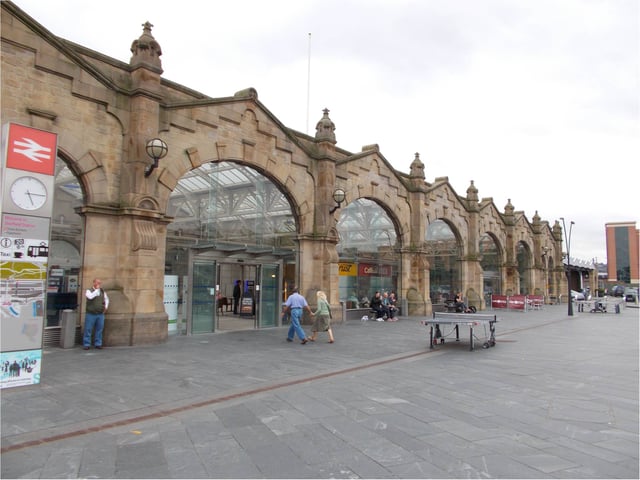
Sheffield railway station, 2013
Major railway routes through Sheffield railway station include the Midland Main Line, which links the city to London via the East Midlands, the Cross Country Route which links the East of Scotland and Northeast of England with the West Midlands and the Southwest, and the lines linking Liverpool and Manchester with Hull and East Anglia.[101] With the redevelopment of London St Pancras station (now St Pancras International) complete, Sheffield has a direct connection to continental Europe. East Midlands Railway run services to St Pancras International and Eurostar run services from there to France and Belgium.[102] The Master Cutler, a named passenger express train running from Sheffield railway station to London St Pancras, provides a direct connection to the capital.
It is planned that High Speed 2 will serve a city centre station in Sheffield, via a spur from the main HS2 line. It is scheduled to be operational by 2033 with services to Birmingham, London, Leeds and Newcastle. There will be four trains an hour serving the station, with journey times to London and Birmingham reduced to 1 hour 19 minutes and 48 minutes respectively.[103]
Other trains serving Sheffield (apart from East Midland Trains) are provided by CrossCountry, TransPennine Express and Northern. Aside from the main railway station there are five other stations in Sheffield. Meadowhall, a bus, rail and tram interchange, is the second largest station and accommodates a number of services including the long distance CrossCountry service. Dore and Totley, Woodhouse, Chapeltown and Darnall stations serve as commuter stations for suburban communities but are also connected to the national rail network.
Coach
Coach services running through Sheffield are operated by National Express and to a lesser extent Megabus, part of the Stagecoach Group. National Express services call at Sheffield Interchange, Meadowhall Interchange and Meadowhead Bus Stop. Megabus services only call at Meadowhall. National Express services 564, 560, 350, 320, 310 and 240 call at Sheffield, as do others on a less frequent basis.[104] The 560/564 service is a direct connection to London Victoria Coach Station via Chesterfield and Milton Keynes, operating 12 times a day in both directions. The 350 and 240 services connect Sheffield to Manchester Airport and Heathrow/Gatwick Airports respectively.[105] Two Megabus services, the M12 and M20, call at Sheffield en route to London from Newcastle upon Tyne and Inverness respectively.[106]
Canal
The Sheffield and South Yorkshire Navigation (S&SY) is a system of navigable inland waterways (canals and canalised rivers) in Yorkshire and Lincolnshire.[107] Chiefly based on the River Don, it runs for a length of 43 miles (69 km) and has 29 locks. It connects Sheffield, Rotherham and Doncaster with the River Trent at Keadby and (via the New Junction Canal) the Aire and Calder Navigation.[108]
Air
Following the closure of Sheffield City Airport in 2008,[109] the closest international airport to Sheffield is Doncaster Sheffield Airport which is located 18 miles (29 km) from the city centre. It operates on the site of the former RAF Finningley. It opened on 28 April 2005 and is served mainly by charter and budget airlines. It handles about one million passengers a year.[110]
A link road, opened in February 2016, connects Doncaster Sheffield Airport to the M18 motorway, reducing the journey time from Sheffield city centre from 40 to 25 minutes.[111] East Midlands Airport is within one hour's drive of the city, and Manchester Airport is connected directly to Sheffield by a direct train every hour.
Local travel
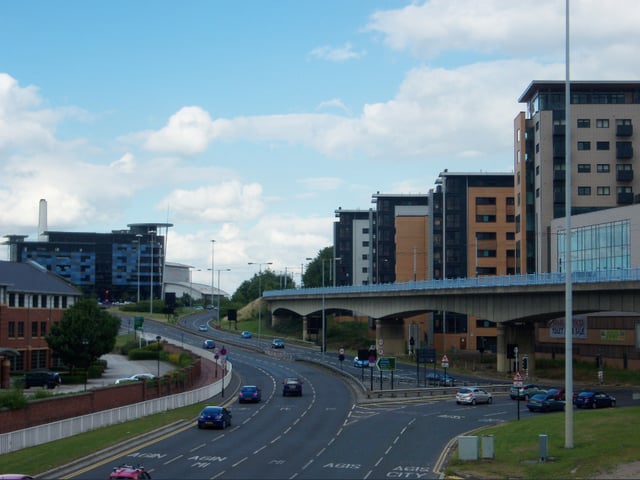
The Sheffield Parkway terminus at Park Square. The opposite end connects to the M1 motorway at Junction 33.
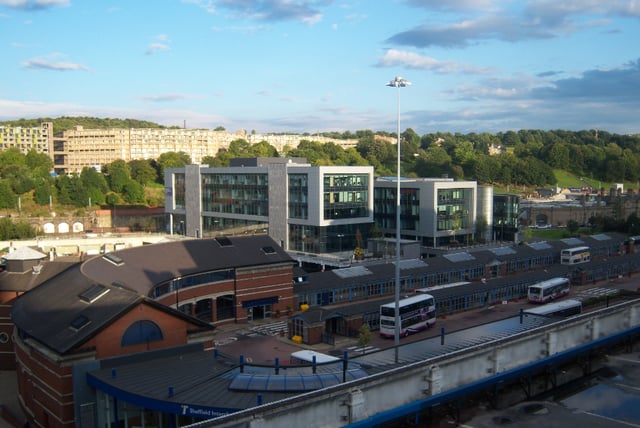
Sheffield Interchange
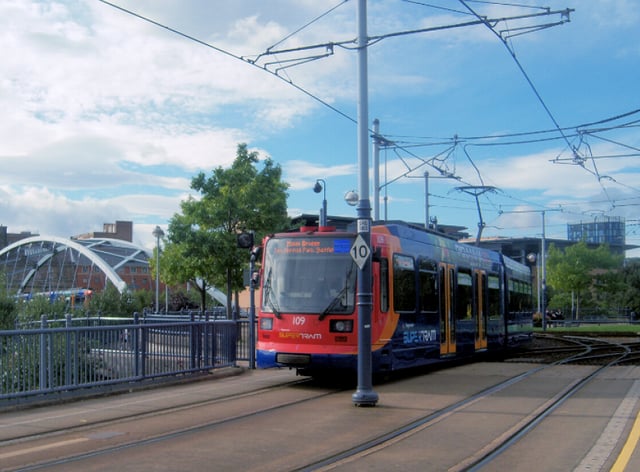
A Sheffield Supertram
The A57 and A61 roads are the major trunk roads through Sheffield.[100] These run east–west and north–south respectively, crossing in the city centre, from where the other major roads generally radiate spoke-like. An inner ring road, mostly constructed in the 1970s and extended in 2007 to form a complete ring,[112] allows traffic to avoid the city centre, and an outer ring road runs to the east, south east and north, nearer the edge of the city, but does not serve the western side of Sheffield.[100]
Sheffield does not have as extensive a suburban and inter-urban railway network as other comparable British cities.[113] However, there are several local rail routes running along the city's valleys and beyond, connecting it with other parts of South Yorkshire, West Yorkshire, Nottinghamshire, Lincolnshire and Derbyshire. These local routes include the Penistone Line, the Dearne Valley Line, the Hope Valley Line and the Hallam Line. As well as the main stations of Sheffield and Meadowhall, there are five suburban stations, at Chapeltown, Darnall, Woodhouse, and Dore & Totley.[114]
The Sheffield Supertram (not derived from the previous tramways), operated by Stagecoach, opened in 1994, shortly after the similar Metrolink scheme in Manchester. Its network consists of 37 miles (60 km) of track and four lines, from Halfway to Malin Bridge (Blue Line), from Meadowhall to Middlewood (Yellow Line), from Meadowhall to Herdings Park (Purple Line),[115] and the tram-train line from Cathedral to Rotherham Parkgate (Black Line), with all four lines running via the city centre. The network operated as three lines for years before it was extended to Rotherham Parkgate in 2018,[116] with a fleet of new "train-trams" sharing a conventional rail line between Sheffield and Rotherham. The system contains both on-street and segregated running, depending upon the section and line.
The Supertram serves as an important connection between areas in the North East of Sheffield (namely Meadowhall and Valley Centertainment) and the city centre. Because it is operated by the Stagecoach Group, the ticketing system for the Supertram is integrated with Stagecoach buses in Sheffield, meaning passengers can switch between the two modes of transport without having to buy a separate ticket.[117] Sheffield's local bus infrastructure has its main hub at Sheffield Interchange. Other bus stations lie at Halfway, Hillsborough and Meadowhall. A flurry of new operators was created after deregulation in 1986,[118] though a series of mergers has reduced the number.
There are numerous bus operators within Sheffield: First South Yorkshire, Stagecoach Yorkshire, TM Travel, Hulleys of Baslow, Powells, G&J Holmes and Sheffield Community Transport. First South Yorkshire, became by far the largest bus operator and in recent years implemented a series of fare rises and service cuts which saw bus ridership drop.[119][120] Recent developments have seen Stagecoach Sheffield taking over Yorkshire Terrier, Andrews and parent company Yorkshire Traction, thus forming one company and in the process expanding their bus services in the city. This has resulted in increased competition, and price drops on certain routes.[121] A zero-fare bus service, the FreeBee (Operated by First South Yorkshire), operated a circular route around the city centre from the Sheffield Interchange. The FreeBee buses stopped in 2014 and is due to save £8 million.[122][123]
There is also the Bus Rapid Transit North route between Sheffield and Maltby via Rotherham. In 2008, the Bus Rapid Transit scheme was approved by the Yorkshire and Humber Assembly's Regional Transport Board and there were plans for two routes; one (the Northern route) to Rotherham via Meadowhall and Templeborough, and the other via the developing employment centre and Waverley.[124] The route between Sheffield and Maltby was approved in 2013 with construction commencing in January 2014, involving the construction of the new 800m Tinsley Road Link between Meadowhall and the A6178 road.[125][126] The route opened in September 2016.[127]
Cycling
For cycling, although hilly, Sheffield is compact and has few major trunk roads. It is on the Trans-Pennine Trail, a National Cycle Network route running from West to East from Southport in Merseyside to Hornsea in the East Riding of Yorkshire and North to South from Leeds in West Yorkshire to Chesterfield in Derbyshire.[128] There are many cycle routes going along country paths in the woods surrounding the city, though very few cycle lanes in the city itself.
Education
Universities and colleges
Sheffield Hallam University (SHU) is a university on two sites in Sheffield. City Campus is located in the city centre, close to Sheffield railway station, and Collegiate Crescent Campus is about two miles away, adjacent to Ecclesall Road in south-west Sheffield. The university is the third largest in the UK, with more than 37,000 students (of whom over 4,000 are international students), 4,170 staff and 747 courses. Sheffield Hallam University's history goes back to 1843 with the establishment of the Sheffield School of Design. During the 1960s several independent colleges (including the School of Design) joined to become Sheffield Polytechnic (Sheffield City Polytechnic from 1976) and was finally renamed Sheffield Hallam University in 1992.
Sheffield has three main further education providers: The Sheffield College, Longley Park Sixth Form College and Chapeltown Academy. The Sheffield College is organised on a federal basis and was originally created from the merger of six colleges around the city, since reduced to just four: Sheffield City (formerly Castle)[131] near the city centre, Hillsborough, serving the north of the city and Norton and Peaks to the south.
Secondary, primary and pre-school education
There are 137 primary schools, 26 secondary schools – of which 10 have sixth forms: (High Storrs, King Ecgberts, King Edward VII, Silverdale, Meadowhead, Tapton, UTC Sheffield, Notre Dame Catholic High, Bradfield and All Saints Catholic High[132]) – and a sixth-form college, Longley Park Sixth Form College.[133] The city's five independent private schools include Birkdale School and the Sheffield High School.[134] There are also 12 special schools and a number of Integrated Resource Units in mainstream schools which are, along with all other schools, managed by Sheffield City Council.[135] All schools are non-selective, mixed sex schools (apart from Sheffield High School which is an all-girls school).[135] The Early Years Education and Childcare Service of Sheffield City Council manages 32 nurseries and children's centres in the city.[135]
Sport
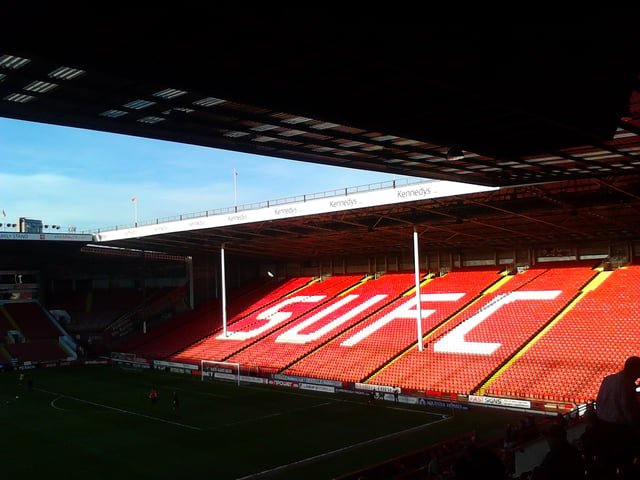
Bramall Lane, the home of Sheffield United, is close to the city centre
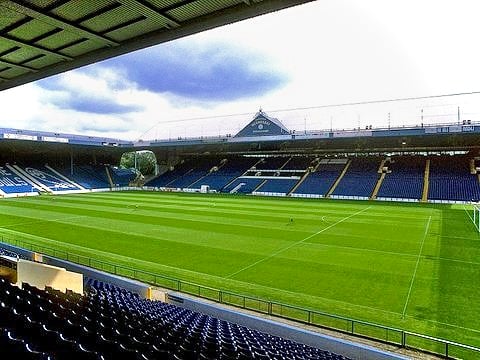
Hillsborough, the home of Sheffield Wednesday, is the city's largest stadium with a capacity of just under 40,000
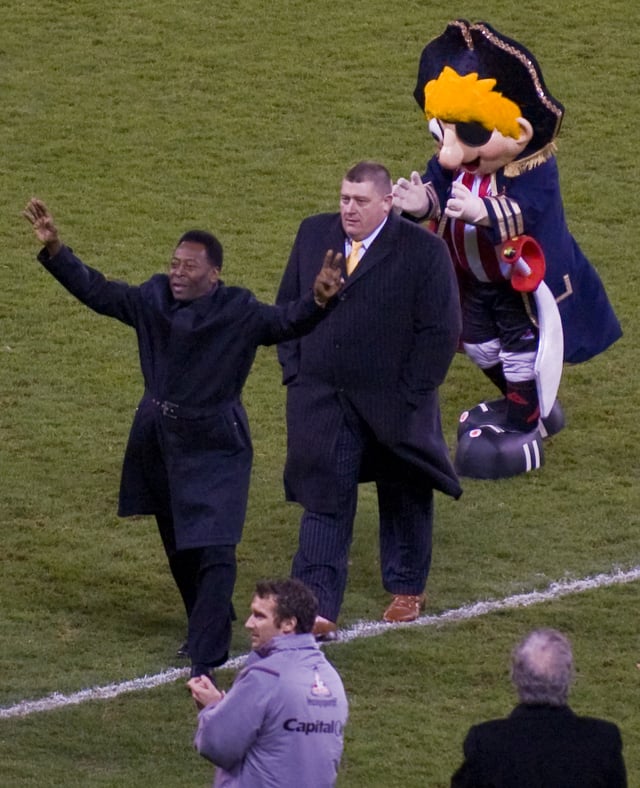
Brazilian legend Pelé (left) in Sheffield in November 2007, marking the 150th anniversary of the world's oldest football club, Sheffield FC[7]
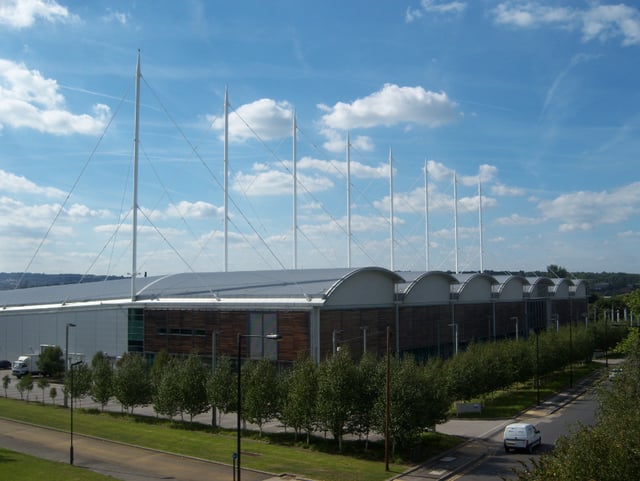
English Institute of Sport, Sheffield
Sheffield has a long sporting heritage. In 1857 a collective of cricketers formed the world's first-ever official football club, Sheffield FC,[136] and the world's second-ever, Hallam FC, who also play at the world's oldest football ground in the suburb of Crosspool. Sheffield and Hallam are today Sheffield's two major non-league sides, although Sheffield now play just outside the city in nearby Dronfield, Derbyshire. Sheffield and Hallam contest what has become known as the Sheffield derby. By 1860 there were 15 football clubs in Sheffield, with the first ever amateur league and cup competitions taking place in the city.[137]
Sheffield is best known for its two professional football teams, Sheffield United, known locally as The Blades, and Sheffield Wednesday, known locally as The Owls. United, who play at Bramall Lane south of the city centre, compete in the Premier League and Wednesday, who play at Hillsborough in the north west of the city, compete in the Football League Championship. The two clubs contest the Steel City Derby, which is considered by many to be one of the most fierce football rivalries in English Football.[138] In the pre-war era, both Wednesday and United enjoyed large amounts of success and found themselves two of the country's top clubs; Sheffield Wednesday have been champions of the Football League four times – in 1902–03, 1903–04, 1928–29 and 1929–30, whilst Sheffield United have won it once, in 1897–98. During the 1970s and early 1980s the two sides fell from grace, with Wednesday finding themselves in the Third Division by the mid 70s and United as far as the Fourth Division in 1981. Wednesday once again became one of England's high-flying clubs following promotion back to the First Division in 1984, winning the League Cup in 1991, competing in the UEFA Cup in 1992–93, and reaching the final of both the League Cup and FA Cup in the same season. United and Wednesday were both founding members of the Premier League in 1992, but The Blades were relegated in 1994. The Owls remained until 2000. Both clubs have gone into decline in the 21st century, Wednesday twice relegated to League One and United suffering the same fate in 2011, despite a brief spell in the Premier League in 2006–07. Sheffield Wednesday's new owner Dejphon Chansiri is aiming for promotion back to the Premier League, which has currently resulted in two unsuccessful play-off campaigns but increased league standings.[139]
Sheffield was the site of the deadliest sports venue disaster in the United Kingdom, the Hillsborough disaster in 1989, when 96 Liverpool supporters were killed in a stampede and crush during an FA Cup semi final at the venue.
Rotherham United, who play in League One, did play their home games in the city between 2008 and 2012, having moved to play at Sheffield's Don Valley Stadium in 2008 following a dispute with their previous landlord at their traditional home ground of Millmoor, Rotherham. However, in July 2012, the club moved to the new 12,000 seat New York Stadium in Rotherham. There are also facilities for golf, climbing and bowling, as well as a newly inaugurated national ice-skating arena (IceSheffield).
Sheffield Eagles RLFC are the city's professional rugby league team who play their matches at Owlerton Stadium. They currently play in the second tier of the professional league, the Championship and are current champions, having won back to back titles in 2012 and 2013. Their most successful moment came in 1998, when, against all the odds they defeated Wigan in the Challenge Cup final, despite being huge underdogs. The team then hit troubled times before reforming in 2003. Since then they have played their rugby in the Championship (second tier). In 2011, they made the playoffs finishing in fifth place. They made the Grand Final, by defeating Leigh, who were huge favourites in a playoff semi final. In the final, they were comprehensively beaten by Featherstone Rovers. Sheffield also put in a bid to be a host city for the 2013 Rugby League World Cup, but their bid was unsuccessful.
Sheffield is also home to the Sheffield Steelers ice hockey team who play out of the 8,500 seater Sheffield Arena. They play in the 10 team professional Elite Ice Hockey League. The National Hockey League's Stanley Cup was made in Sheffield in 1892. Sheffield is also home to the Sheffield Steel Rollergirls, a roller derby team.
Many of Sheffield's sporting facilities were built for the World Student Games, which the city hosted in 1991, including Sheffield Arena and the Ponds Forge international diving and swimming complex. Ponds Forge is also the home of Sheffield City Swimming Club, a local swimming club competing in the Speedo league. The former Don Valley International Athletics Stadium, once the largest athletics stadium in the UK, was also constructed for the Universiade games.[140]
The Sheffield Ski Village was the largest artificial ski resort in Europe, before being destroyed in a series of suspected arson attacks in 2012 and 2013. The city also has two indoor climbing centres. Sheffield was the UK's first National City of Sport and is now home to the English Institute of Sport – Sheffield, where British athletes trained for the 2012 Olympics.[141]
Sheffield also has close ties with snooker, with the city's Crucible Theatre being the venue for the World Snooker Championships.[142] The English Institute of Sport hosts most of the top fencing competitions each year, including the National Championships for Seniors, Juniors (U20's) and Cadets (U17's) as well as the 2011 Senior European Fencing Championships. The English squash open is also held in the city every year. The International Open and World Matchplay Championship bowls tournaments have both been held at Ponds Forge.[143] The city also hosts the Sheffield Tigers rugby union, Sheffield Sharks, American Football team the Sheffield Giants, basketball, Sheffield University Bankers hockey, Sheffield Steelers ice hockey and Sheffield Tigers speedway teams. Sheffield also has many golf courses all around the city.
Sheffield hosted the finish of Stage 2 of the 2014 Tour de France. Within the City limits and located just 4 kilometres (2.5 mi) from the finish, was the ninth and final climb of the stage, the Category 4 Côte de Jenkin Road. The one point in the King of the Mountains competition was claimed by Chris Froome of Team Sky. The climb was just 0.8 kilometres (0.50 mi) long at an average gradient of 10.8%. The stage was won by the eventual overall winner, Vincenzo Nibali of Astana Pro Team.[146]
Culture and attractions
Sheffield made the shortlist for the first city to be designated UK City of Culture, but in July 2010 it was announced that Derry had been selected.[147]
Attractions

Bishops' House

The Grade II* listed Weston Park Museum
The Sheffield Walk of Fame in the City Centre honours famous Sheffield residents past and present in a similar way to the Hollywood version.[148] Sheffield also had its own Ferris Wheel known as the Wheel of Sheffield, located atop Fargate shopping precinct. The Wheel was dismantled in October 2010 and moved to London's Hyde Park.[149] Heeley City Farm and Graves Park are home to Sheffield's two farm animal collections, both of which are fully open to the public.[150][151] Sheffield also has its own zoo; the Tropical Butterfly House, Wildlife & Falconry Centre.[152]
There are about 1,100 listed buildings in Sheffield (including the whole of the Sheffield postal district).[153] Of these, only five are Grade I listed. Sixty-seven are Grade II*, but the overwhelming majority are listed as Grade II.[154] Compared to other English cities, Sheffield has few buildings with the highest Grade I listing: Liverpool, for example, has 26 Grade I listed buildings. This situation led the noted architecture historian Nikolaus Pevsner, writing in 1959, to comment that the city was "architecturally a miserable disappointment", with no pre-19th-century buildings of any distinction.[155] By contrast, in November 2007, Sheffield's Peace and Winter Gardens beat London's South Bank to gain the Royal Institute of British Architects' Academy of Urbanism "Great Place" Award, as an "outstanding example of how cities can be improved, to make urban spaces as attractive and accessible as possible".[156] In the summer of 2016 a public art event across the city occurred called the Herd of Sheffield which raised £410,000 for the Sheffield Children's Hospital.[157]
Music
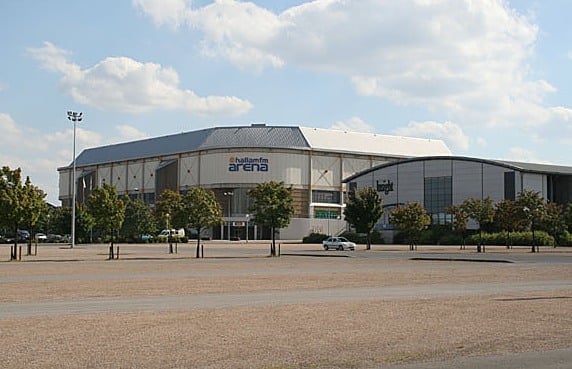
Sheffield Arena
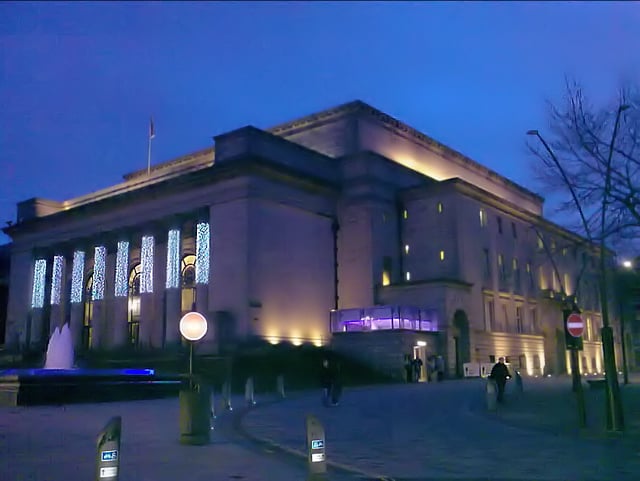
Sheffield City Hall, a Grade II* listed building
Sheffield has been home to several well-known bands and musicians, with a notably large number of synthpop and other electronic bands originating from the city.[158] These include The Human League, Heaven 17, ABC and the more industrially inclined Cabaret Voltaire & Clock DVA. This electronic tradition has continued: techno label Warp Records was a central pillar of the Yorkshire Bleeps and Bass scene of the early 1990s, and has gone on to become one of the UK's oldest and best-loved dance music labels. More recently, other popular genres of electronic music such as bassline house have originated in the city.[159] Sheffield was once home to a number of historically important nightclubs in the early dance music scene of the 1980s and 1990s, Gatecrasher One was one of the most popular clubs in the North of England until its destruction by fire on 18 June 2007.[160]
A number of major music acts, including Joe Cocker, Def Leppard, Arctic Monkeys, Bring Me the Horizon, Rolo Tomassi, While She Sleeps, Pulp and Moloko, hail from the city.[161][162][163][164] Indie band The Long Blondes originated from the city,[165] as part of what the NME dubbed the New Yorkshire scene.[166]
In 1999 the National Centre for Popular Music, a museum dedicated to the subject of popular music, was opened in the city.[167] It was not as successful as was hoped, however, and later evolved to become a live music venue; then in February 2005, the unusual steel-covered building became the students' union for Sheffield Hallam University.[168] Live music venues in the city include the Harley Hotel, Leadmill, West Street Live, the Boardwalk, Dove & Rainbow, The Greystones, The Casbah, The Cremorne, Corporation, New Barrack Tavern, The Broadfield Hotel, Redstone bar and nightclub, the City Hall, the University of Sheffield Students' Union, the Studio Theatre at the Crucible Theatre, the O2 Academy Sheffield and The Grapes.[169][170][171][172][173][174]
Sheffield hosts a number of festivals, the Grin Up North Sheffield Comedy Festival,[175] the Sensoria Music & Film Festival and the Tramlines Festival. The Tramlines Festival was launched as an annual music festival in 2009,[176] it is held throughout venues in Sheffield City Centre, and features local and national artists.[177]
The city is home to several local orchestras and choirs, such as the Sheffield Symphony Orchestra, the Sheffield Philharmonic Orchestra, the Sheffield Chamber Orchestra, the City of Sheffield Youth Orchestra, the Sheffield Philharmonic Chorus and the Chorus UK community choir.[178][179][180][181] It is also home to Music in the Round, a charitable organisation that exists to promote chamber music. It describes itself as the largest promoter of chamber music outside London.
Theatres

The Crucible Theatre (centre) and Lyceum Theatre (right)
Sheffield has two large theatres, the Lyceum Theatre and the Crucible Theatre, which together with the smaller Studio Theatre make up the largest theatre complex outside London, located in Tudor Square.[182] The Crucible Theatre is the home (since 1977) of the World Snooker Championships and hosts many well-known stage productions throughout the year. The Lyceum, which opened in 1897, serves as a venue for touring West End productions and operas by Opera North, as well as locally produced shows. Sheffield also has the Montgomery Theatre, a small 420 seater theatre located a short distance from Tudor Square, opposite the town hall on Surrey Street.[183] There are also a large number of smaller amateur theatres scattered throughout the city.
Museums
Sheffield's museums are managed by two distinct organisations. Museums Sheffield manages the Weston Park Museum (a Grade II* listed Building), Millennium Galleries and Graves Art Gallery.[184] Sheffield Industrial Museums Trust manages the museums dedicated to Sheffield's industrial heritage of which there are three.[185] Kelham Island Museum (located just to the North of the city centre) showcases the city's history of steel manufacturing.[186] Abbeydale Industrial Hamlet (in the south of the city) is a Grade I Listed building and a Scheduled Ancient Monument.[187] Shepherd Wheel (in the south-East of the city) is a former water-powered grinding workshop, Grade II listed and a Scheduled Ancient Monument.[188] Also there are Sheffield Archives.
Greenspace
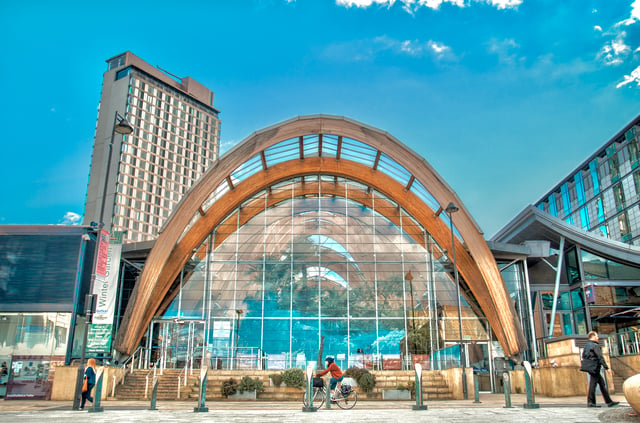
Sheffield Winter Gardens & St Paul's Tower
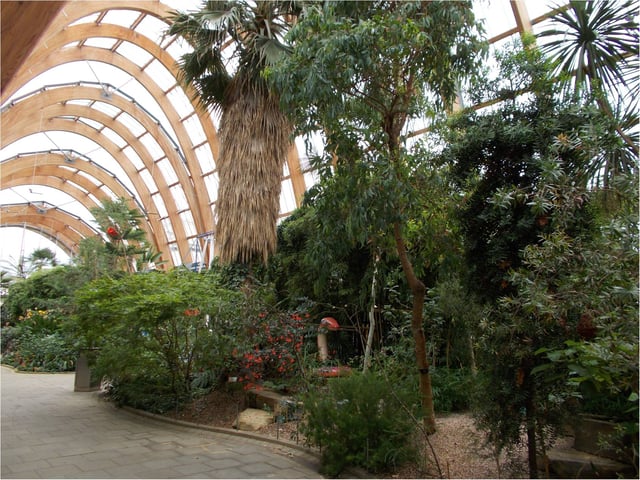
Sheffield Winter Garden – inside 2013
Sheffield has a reputed 4.5 million trees[5] and has been described as the greenest city in Europe,[189] despite a large number of highway tree fellings taking place across the city since 2012.[190] There are many parks and woods throughout the city and beyond. Containing more than 250 parks, woodlands and gardens, there are around 78 public parks and 10 public gardens in Sheffield,[4] including 83 managed parks (13 'City' Parks, 20 'District' Parks and 50 'Local' Parks) located throughout the city.[191] Included in the city parks category are 3 of Sheffield's 6 public gardens (the Sheffield Botanical Gardens, the Peace Gardens and Hillsborough Walled Gardens, with the Sheffield Winter Gardens, Beauchief Gardens and Lynwood Gardens being the separate entities).
The Sheffield Botanical Gardens are on a 19-acre site located to the south west of the city centre and date back to 1836. The site includes a large, Grade II listed, Victorian era glasshouse. The Peace Gardens, neighboured next to the Town Hall and forming part of the Heart of the City project, occupy a 0.67 hectares (1.7 acres) site in the centre of the city. The site is dominated by its water features, principal among which is the Goodwin Fountain. Made up of 89 individual jets of water, this fountain lies at the corner of the quarter-circle shaped Peace Gardens and is named after Stuart Goodwin, a notable Sheffield industrialist. Since their redevelopment in 1998, the Peace gardens have received a number of regional and national accolades.[192] Hillsborough Walled Garden is located in Hillsborough Park, to the north-west of the city centre. The gardens date back to 1779 and have been dedicated to the victims of the Hillsborough Disaster since the redevelopment of the gardens in the early 1990s.[193] The Winter Garden, lying within the Heart of the City, is a large wood framed, glass skinned greenhouse housing some 2,500 plants from around the world.[194]
The South West boundary of the city overlaps with the Peak District National Park, the first national park in England (est. 1951).[196] As a consequence, several communities actually reside within both entities. The Peak District is home to many notable, natural, features and also man-made features such as Chatsworth House, the setting for the BBC series Pride and Prejudice.[197]
Entertainment
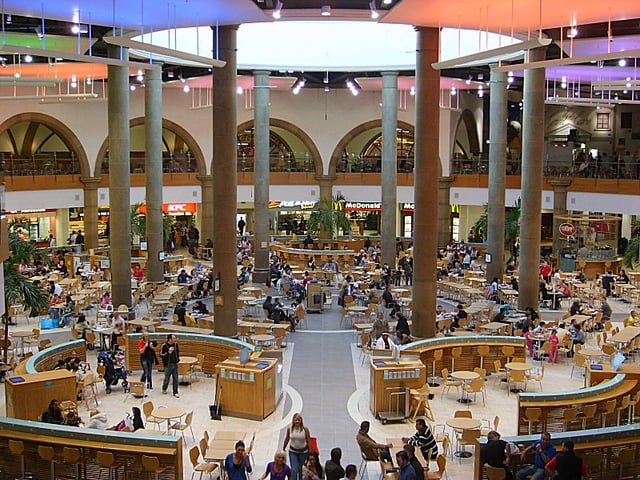
The Oasis food court at Meadowhall Centre
Sheffield has six cinema complexes, four of which are in the city centre and a further two in the Lower Don Valley. One of these complexes is located at Valley Centertainment, a leisure and entertainment complex in the Don Valley. It was built on land previously occupied by steel mills near what is now Meadowhall and the Sheffield Arena. It is home to several restaurants, bars, a cinema multiplex and a bowling alley.[199] It is also the largest Cineworld complex in the United Kingdom, containing 20 screens in one building.[200] Odeon Sheffield, situated on Arundel Gate in the city Centre and Vue, located within Meadowhall Shopping Centre, are the two other mainstream cinemas in the city. The Showroom, an independent cinema showing non-mainstream productions, is located in Sheaf Square, close to Sheffield station. In 2002 the Showroom was voted as the best Independent cinema in the country by Guardian readers.[201] A Curzon Cinemas complex is based in the former Sheffield Banking Company building, located just off Arundel Gate. The cinema features 4K resolution projectors and was opened in January 2015.[202][203] Sheffield's newest cinema, The Light (Sheffield), opened just off The Moor in 2018.
Sheffield has a thriving poetry and spoken word scene: from Wordlife's [249] events across the city to the sustained work of Sheffield Authors [250] ; from the vibrant monthly arts night, Verse Matters [251] , at the Moor Theatre Deli [252] to the longstanding work of The Poetry Business [253] , there's always opportunities for new and experienced writers to get writing and to share their work.
Owing to its long history, Sheffield has a large number of pubs throughout the city. West Street, running through the heart of the West End district of the city centre, is home to many pubs, bars and clubs and attracts many student visitors. A recent addition to the city's nightlife is Leopold Square, situated just off the northern end of West Street. Aagrah, an Indian restaurant in the square which serves Kashmiri cuisine, has recently been voted "Best Restaurant Group in the UK" at the prestigious British Curry Awards.[204]
Media and film
Sheffield has two commercial newspapers, The Star and Sheffield Telegraph, both published by Johnston Press PLC. The Star has been published daily since 1897; the Sheffield Telegraph, now a weekly publication, originated in 1855.[205]
Sheffield has its own TV station; Sheffield Live TV, a not-for-profit company which began broadcasting on 23 September 2014.[206] SLTV has been awarded a 12-year licence to provide the digital terrestrial broadcasting service.[207][208][209] Regional broadcasters BBC Yorkshire and Yorkshire Television also cover the city. Five local radio stations broadcast in the city. The professional services are BBC Radio Sheffield, the independent Hallam FM and its sister station Magic AM. Sheffield is also home to two FM licensed community radio stations: Sheffield Live 93.2, and Burngreave Community Radio on 103.1.
Sheffield Hospital Radio (Hospital Broadcasting Sheffield) broadcasts a 24-hour service to the Royal Hallamshire, Jessop Wing, Northern General and Weston Park Hospital and also offers a dedicated patient visiting service. The charity is operated by volunteers from studios at the Royal Hallamshire Hospital and is provided free to bedside terminals via Hospedia and on medium wave 1431am from a transmitter at the Northern General Hospital.[210]
The films and plays The Full Monty, Threads, Looks and Smiles, When Saturday Comes, Whatever Happened to Harold Smith?, The History Boys and Four Lions are set in the city.[211] F.I.S.T., Kill List, '71 and The Princess Bride also include several scenes filmed in Sheffield and a substantial part of Among Giants[212] was filmed in the city. The documentary festival Sheffield Doc/Fest has been run annually since 1994 at the Showroom Cinema,[213] and in 2007 Sheffield hosted the Awards of the International Indian Film Academy.[214] The 2018 series of Doctor Who, which features the Park Hill estate and other Sheffield locations, premiered in Sheffield.[215]
Folk culture
Sheffield has a thriving folk music, song and dance community. Singing and music sessions occur weekly in many pubs around the city and it also hosts the annual Sheffield Sessions Festival.[216] The University of Sheffield runs a number of courses and research projects dedicated to folk culture.[217]
The tradition of singing carols in pubs around Christmas is still kept alive in the city. The Sheffield Carols, as they are known locally, predate modern carols by over a century and are sung with alternative words and verses.[218] Although there is a core of carols that are sung at most venues, each particular place has its own mini-tradition. The repertoire at two nearby places can vary widely, and woe betide those who try to strike up a ‘foreign’ carol. Some are unaccompanied, some have a piano or organ, there is a flip chart with the words on in one place, a string quartet (quintet, sextet, septet) accompanies the singing at another, some encourage soloists, others stick to audience participation, a brass band plays at certain events, the choir takes the lead at another.[219] It is thought this tradition is now unique in Britain.
The city is home to thirteen morris dance teams – thought to be one of the highest concentration of sides in the country. Nearly all forms of the dance are represented in the city, including Cotswold (Five Rivers Morris,[220] Pecsaetan Morris,[221] Harthill Morris,[222] Lord Conyer's Morris Men,[223] Sheffield City Morris,[224] William Morris[225]), border (Boggart's Breakfast[226]), North West (Yorkshire Chandelier,[227] Silkstone Greens,[228] Lizzie Dripping[229]), rapper (Sheffield Steel Rapper[230]) and Yorkshire Longsword.
Public services
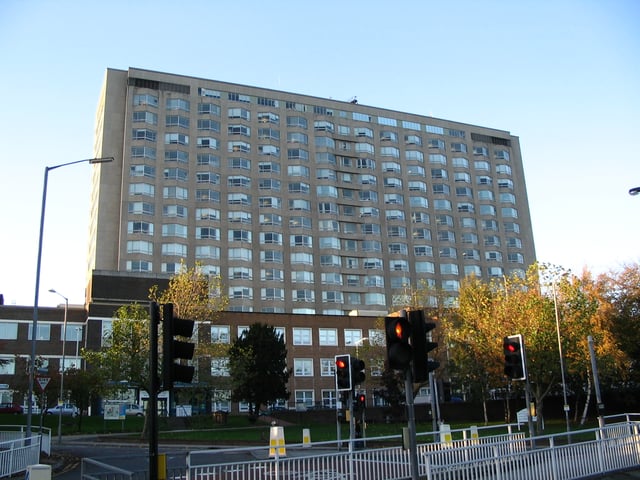
The Royal Hallamshire Hospital
Sheffield is policed by South Yorkshire Police (a territorial police force) whose headquarters are in the city. Sheffield constitutes one of its four Districts (Barnsley, Doncaster and Rotherham being the other three).[231] The force polices an area of approximately 1,554 square kilometres and is the 13th largest force in England, Wales and Northern Ireland.
Medical services in Sheffield are provided by three NHS Foundation Trusts. Sheffield Teaching Hospitals NHS Foundation Trust provides healthcare to people (primarily adults) throughout Sheffield and South Yorkshire. The trusts title includes the word 'teaching' because it undertakes training of medical students at the University of Sheffield and has strong links to Sheffield Hallam University as well. The trust has two campuses: The West Campus containing the Royal Hallamshire Hospital, the Jessop Wing (maternity wing), Weston Park Hospital (specialist cancer treatment) and Charles Clifford Dental Hospital. The Northern General Hospital is the second 'campus' and is a large facility in the northern suburbs of Sheffield, containing the city's A&E department. Sheffield Children's NHS Foundation Trust provides healthcare for children within the city of Sheffield, South Yorkshire and the UK as a whole.[232]
Sheffield Health and Social Care NHS Foundation Trust provides mental health services, services for people with learning disabilities, substance misuse services, long term neurological conditions, as well as a consortium of GP practises.[233] The Sheffield Institute for Motor Neurone Disease (also known as Sheffield Institute for Translational Neuroscience – SITraN) has been developed by the University of Sheffield.[234]
Sister cities
The 'Sheffield International Linking Committee' promotes Sheffield overseas, especially with five sister cities:[239]
[[INLINE_IMAGE|//upload.wikimedia.org/wikipedia/commons/thumb/f/fa/Flag_of_the_People%27s_Republic_of_China.svg/23px-Flag_of_the_People%27s_Republic_of_China.svg.png|//upload.wikimedia.org/wikipedia/commons/thumb/f/fa/Flag_of_the_People%27s_Republic_of_China.svg/35px-Flag_of_the_People%27s_Republic_of_China.svg.png 1.5x, //upload.wikimedia.org/wikipedia/commons/thumb/f/fa/Flag_of_the_People%27s_Republic_of_China.svg/45px-Flag_of_the_People%27s_Republic_of_China.svg.png 2x|China|h15|w23|thumbborder flagicon-img flagicon-img]] Chengdu, China
[[INLINE_IMAGE|//upload.wikimedia.org/wikipedia/commons/thumb/f/fa/Flag_of_the_People%27s_Republic_of_China.svg/23px-Flag_of_the_People%27s_Republic_of_China.svg.png|//upload.wikimedia.org/wikipedia/commons/thumb/f/fa/Flag_of_the_People%27s_Republic_of_China.svg/35px-Flag_of_the_People%27s_Republic_of_China.svg.png 1.5x, //upload.wikimedia.org/wikipedia/commons/thumb/f/fa/Flag_of_the_People%27s_Republic_of_China.svg/45px-Flag_of_the_People%27s_Republic_of_China.svg.png 2x|China|h15|w23|thumbborder flagicon-img flagicon-img]] Anshan, China
[[INLINE_IMAGE|//upload.wikimedia.org/wikipedia/en/thumb/b/ba/Flag_of_Germany.svg/23px-Flag_of_Germany.svg.png|//upload.wikimedia.org/wikipedia/en/thumb/b/ba/Flag_of_Germany.svg/35px-Flag_of_Germany.svg.png 1.5x, //upload.wikimedia.org/wikipedia/en/thumb/b/ba/Flag_of_Germany.svg/46px-Flag_of_Germany.svg.png 2x|Germany|h14|w23|thumbborder flagicon-img flagicon-img]] Bochum, Germany
[[INLINE_IMAGE|//upload.wikimedia.org/wikipedia/commons/thumb/4/49/Flag_of_Ukraine.svg/23px-Flag_of_Ukraine.svg.png|//upload.wikimedia.org/wikipedia/commons/thumb/4/49/Flag_of_Ukraine.svg/35px-Flag_of_Ukraine.svg.png 1.5x, //upload.wikimedia.org/wikipedia/commons/thumb/4/49/Flag_of_Ukraine.svg/45px-Flag_of_Ukraine.svg.png 2x|Ukraine|h15|w23|thumbborder flagicon-img flagicon-img]] Donetsk, Ukraine
[[INLINE_IMAGE|//upload.wikimedia.org/wikipedia/commons/thumb/1/19/Flag_of_Nicaragua.svg/23px-Flag_of_Nicaragua.svg.png|//upload.wikimedia.org/wikipedia/commons/thumb/1/19/Flag_of_Nicaragua.svg/35px-Flag_of_Nicaragua.svg.png 1.5x, //upload.wikimedia.org/wikipedia/commons/thumb/1/19/Flag_of_Nicaragua.svg/46px-Flag_of_Nicaragua.svg.png 2x|Nicaragua|h14|w23|thumbborder flagicon-img flagicon-img]] Estelí, Nicaragua
A further four cities have a Friendship Agreement with Sheffield:
[[INLINE_IMAGE|//upload.wikimedia.org/wikipedia/en/thumb/9/9e/Flag_of_Japan.svg/23px-Flag_of_Japan.svg.png|//upload.wikimedia.org/wikipedia/en/thumb/9/9e/Flag_of_Japan.svg/35px-Flag_of_Japan.svg.png 1.5x, //upload.wikimedia.org/wikipedia/en/thumb/9/9e/Flag_of_Japan.svg/45px-Flag_of_Japan.svg.png 2x|Japan|h15|w23|thumbborder flagicon-img flagicon-img]] Kawasaki, Japan
[[INLINE_IMAGE|//upload.wikimedia.org/wikipedia/commons/thumb/0/06/Flag_of_Zambia.svg/23px-Flag_of_Zambia.svg.png|//upload.wikimedia.org/wikipedia/commons/thumb/0/06/Flag_of_Zambia.svg/35px-Flag_of_Zambia.svg.png 1.5x, //upload.wikimedia.org/wikipedia/commons/thumb/0/06/Flag_of_Zambia.svg/45px-Flag_of_Zambia.svg.png 2x|Zambia|h15|w23|thumbborder flagicon-img flagicon-img]] Kitwe, Zambia
[[INLINE_IMAGE|//upload.wikimedia.org/wikipedia/commons/thumb/3/32/Flag_of_Pakistan.svg/23px-Flag_of_Pakistan.svg.png|//upload.wikimedia.org/wikipedia/commons/thumb/3/32/Flag_of_Pakistan.svg/35px-Flag_of_Pakistan.svg.png 1.5x, //upload.wikimedia.org/wikipedia/commons/thumb/3/32/Flag_of_Pakistan.svg/45px-Flag_of_Pakistan.svg.png 2x|Pakistan|h15|w23|thumbborder flagicon-img flagicon-img]] Kotli, Pakistan-administered Kashmir
[[INLINE_IMAGE|//upload.wikimedia.org/wikipedia/en/thumb/a/a4/Flag_of_the_United_States.svg/23px-Flag_of_the_United_States.svg.png|//upload.wikimedia.org/wikipedia/en/thumb/a/a4/Flag_of_the_United_States.svg/35px-Flag_of_the_United_States.svg.png 1.5x, //upload.wikimedia.org/wikipedia/en/thumb/a/a4/Flag_of_the_United_States.svg/46px-Flag_of_the_United_States.svg.png 2x|United States|h12|w23|thumbborder flagicon-img flagicon-img]] Pittsburgh, United States - This is mainly due to both cities link with the Steel with both cities being known as Steel City.
Two roads in Sheffield have been named after sister cities; a section of the A6102 in Norton is named Bochum Parkway, and a road in Hackenthorpe is named Donetsk Way. Likewise in Bochum, Germany there is a major road called the Sheffield-Ring.
See also
List of metropolitan areas in Europe
List of people from Sheffield
List of companies in Sheffield
List of pubs in Sheffield
People of Sheffield
Timeline of Sheffield history




